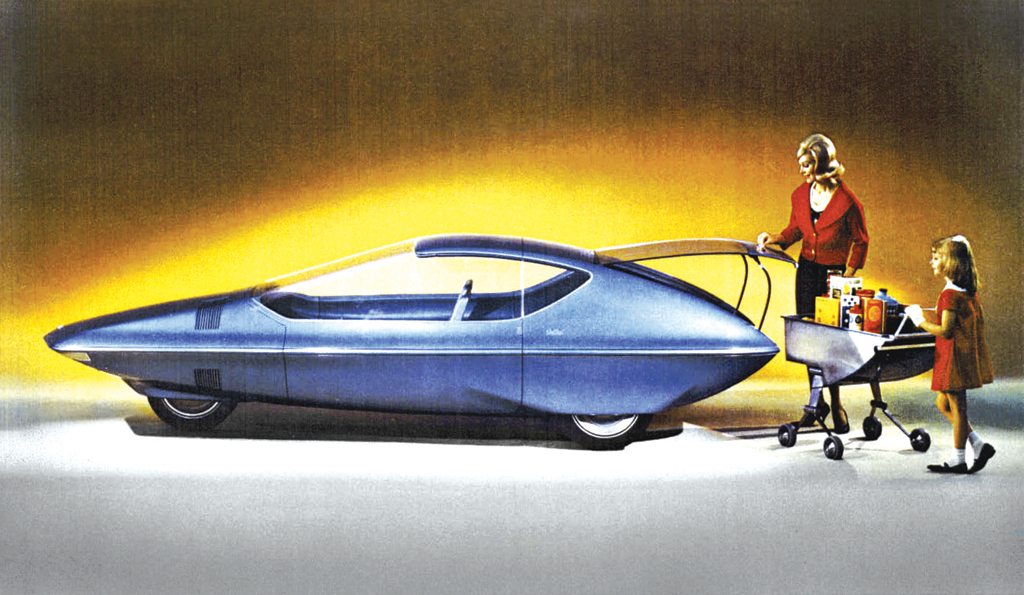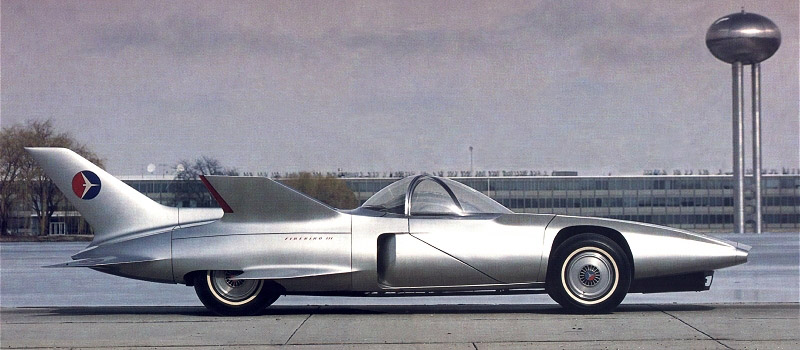Because of the popularity of my last post on the top five science-fictional Golden Age airplanes, this week I’m going to take a look at another mode of transportation — five American automobiles that looked like they could have driven right out of a pulp magazine cover or a cinema instead of a showroom.
From the bubbly, Googie-inspired 1950s on into the sleek, jet-setting 1960s, the automobile was one of the ultimate symbols of American identity. And back then, for a while it seemed as if the entire national culture was giddy to redesign itself entirely around them; some plans for the cities of tomorrow included soaring roadways cutting through the middle of skyscrapers, and one proposal that nearly made it to reality called for blanketing all of downtown Washington, DC, in a complex network of interchanges.
Around that time, automobile manufacturers really started getting into the idea of concept cars — vehicles that gave hungry buyers a mouth-watering glimpse of tomorrow’s dreamlike designs and mind-blowing engineering. In vehicles like these, who wouldn’t mind living in a world where six-lane skyways rumbled all night long directly below the space-age linoleum of your fiftieth-floor apartment?
| #5: 1958 Ford Nucleon — One of the defining motifs of the 1950s was The Atom. Whether it was in the form of Your Friend or Duck and Cover, atoms were everywhere. Evidently the engineers at Ford decided that your trunk would be a good place to put some, too.
The Nucleon was never mocked up to full scale, which is perhaps fortunate because then they might have been tempted to try test-fitting a real reactor in it. Not to mention the heavy-duty shocks required to haul all the lead shielding around. One feature of this car, however, did make it into production twenty years later with the Ford Pinto — the highly explosive trunk. |
| #4: 1959 Cadillac Cyclone — Known more for designing cars suited for old guys, in 1959 Cadillac made a bid for the space-age set with the Cyclone, which was designed to look like it was equipped with missiles on either side. (Car designers referred to the pointy ends as Dagmars, in reference to a well-endowed TV personality of the era.)
One of the last brainchildren of the legendary car designer Harley Earle, the Cyclone was perhaps the first car fitted with radars (of course, located in the Dagmars). The bubble canopy — an iconic requirement of any space age design — slid open electrically along rails and was silver coated to block UV rays that would otherwise bake the occupants on sunny days. |
| #3: 1961 Ford Gyron — The ultimate dream of any space-age driver was, of course, a hovercar. In 1961, Ford came as close as anyone probably could to realizing that dream with the two-wheeled Gyron. Striving for the Jetsons’ ideal of a car that’s all bubble canopy and no fuselage, the Gyron used gyroscopes (and two discreet training wheels on some demo versions) to balance the car.
Plus, it borrowed from the dominant fighter-plane aesthetic of the day, featuring things like a singing canopy in place of doors and a center-mounted joystick for steering. Can you imagine banking into a curve in one of these? Plus, the first 500 buyers would get a deck of playing cards and clothespins to attach them to the spokes. |
| #2: 1964 GM Runabout — If a bicycle car is too outrageous, how about a three-wheeler instead? As the 1950s gave way to the 1960s, car designers began paring away ostentatious things like fins and bubble canopies and began designing concept cars with more practical, less radical looks. The 1964 GM runabout is perhaps the classic example. While it doesn’t look like it will fly you into space all by istelf, it could easily be the car that takes you to the spaceport. I mean, look: the mom isn’t wearing a silver spacesuit and the grocery cart isn’t being pushed by a robot (unless the kid is an android).
I know, compared to the other designs here, this one’s probably the most boring, right? Well, first of all, it’s designed by the same guys who did Buicks and Pontiacs, so give them a little credit. And second, this really looks like something off of Syd Mead’s drawing board. If it had been, then you’d be all “Ooh! Cool!” on it. So just pretend that the mom is really a Nexus 6. And in one of the grocery bags is an artificial python. Now isn’t that a cool car? |
| #1: 1958 GM Firebird III — What could be more ridiculous than a nuclear reactor in your trunk? Try a jet engine. The GM Firebird III was the last and the craziest of a series of Harley Earle designs between 1956 and 1959 that were built around actual jet engines. While great at keeping tailgaters from getting too close, jet engines posed practical problems too — like having to stop off at the nearest airport every time you wanted a fill-up.
Made from super-exotic titanium, the Firebird III had a starship’s worth of gizmos like cruise control and anti-lock brakes and the obligatory center-mounted joystick, not to mention air brakes that deployed from the side panels like flaps — seriously, now that is cool. And if one bubble canopy is good, then two must be great, right? The Firebird III had one for each occupant. Now while that might seem to inhibit casual conversation along the lines of Get Smart’s cone of silence, it could come in really handy when transporting your back-seat-driving mother-in-law. All of which adds up to making the GM Firebird III the winningest science-fictional concept car in our book! |








Years ago there was some discussion about the Cyclone being so similar to Speed Racer’s Mach 5, though it’s not entirely clear which came first.
In any case, with everything on the road now looking a lot like a Toyota Camry variant, I’d take a Cyclone any day. Wonder where you’d put the kid seats in the thing?
As for the Pinto mention, one of the defining jokes of the era was about a Pinto jammed in reverse, shod with Firestone 500 tires and driven by Leon Spinks.
If you don’t get it, you’re just not old enough.
Actually, my first car was a Pinto. It was a really cool car, the four days that it ran well. Anyway, GM needs to look at that Runabout again!
My first was a 1964 Ford Falcon, whose only Sci-Fi component was its ability to pass freely between this universe and the parallel universe where it died and wouldn’t start.
As for the GM Runabout, I think the Reliant Robin did away with the idea of a three-wheel car.
Thanks for the laughs re: the Robin! That’s classic. I can see why they didn’t catch on. Although I love how he could push the driver’s side door open to right the car. That should have come standard.
My first car was a canary yellow 1972 Volvo 144S four-door battle tank, which a talented friend of mine rigged with a special effects sound board in the dash and a speaker behind the front grill so I could blast people with “phasers” and other corny sound effects as I drove.
I used to have an old Air Force pilot helmet in the car. When people would tailgate me, I’d make a show of donning the helmet and lowering the shaded visor, and then I’d grin like a maniac into the rearview mirror. Worked every time. Ah, the days of youth.
Was it the helmet that scared them or the Volvo?
My family had the 1970 wagon version of that Volvo (though not the helmet), and wow. What a chick magnet. That and membership in the chess club kept the babes flowing in a steady stream in high school.